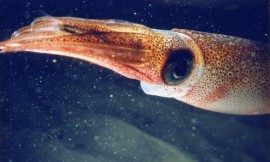
Squid fishermen in and around Monterey Bay are experiencing early success this season with California market squid, which may be a result of a couple of happy accidents.
Half Moon Bay fisherman Michael McHenry says conservation efforts such as closed areas, a ban on weekend fishing and limiting the areas accessible to light boats have allowed the squid population to flourish. While the majority of squid fishing in California takes place in the southern half of the state, he said the bloom of California market squid in Monterey has brought many fishing boats north.
“With these conservation efforts in place, the squid laid enough eggs in the ocean that they actually bloomed out of control,” McHenry said. “We’re able to fill our [yearly] quota six months early, and the squid have six months to spawn without being harassed. It’s a win-win deal. It seems to be a very sustainable fishery at this point.”
The Market Squid Fishery Management Plan, set forth by the state of California in 2005, limits the annual total California market squid catch to 118,000 tons, most of which is exported to China. When the quota is reached, fishing ceases.
There is no denying that conservation efforts are important in squid fishery management, said William Gilly, a Biology Professor at Stanford University’s Hopkins Marine Station, but he said he thinks there may be other factors that play a larger role in the recent market squid abundance. Gilly has been studying the much larger Humboldt squid for almost 15 years and believes that their recent decline is related to the increase in market squid.